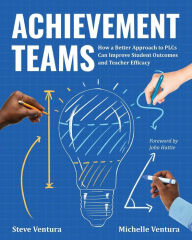Achievement Teams: How a Better Approach to PLCs Can Improve Student Outcomes and Teacher Efficacy. Steve Ventura, Michelle Ventura

Achievement-Teams-How-a-Better.pdf
ISBN: 9781416631194 | 150 pages | 4 Mb

- Achievement Teams: How a Better Approach to PLCs Can Improve Student Outcomes and Teacher Efficacy
- Steve Ventura, Michelle Ventura
- Page: 150
- Format: pdf, ePub, fb2, mobi
- ISBN: 9781416631194
- Publisher: ASCD
Free ebook download online Achievement Teams: How a Better Approach to PLCs Can Improve Student Outcomes and Teacher Efficacy PDF 9781416631194
What if you had a collaborative process of looking at student data that could pinpoint student gaps in learning and suggest effective strategies to close those gaps? What if you knew not only what you should start doing to enhance student learning, but also what you should stop doing because it hasn't given you the hoped-for results? Enter Achievement Teams. This is not another program that's here today and gone tomorrow; it's a timeless approach that any school or district can replicate that focuses on the most significant variable in student achievement: teaching. In Achievement Teams, Steve Ventura and Michelle Ventura offer a framework based on John Hattie's Visible Learning research that makes teacher collaboration more efficient, rigorous, satisfying, and effective. Think of it as a systematic treasure hunt for best practices using real data on your students. The authors walk you through the Achievement Teams four-step meeting protocol: * In Step 1, teams focus on the evidence from a pre-assessment to provide specific feedback to students and teachers about concepts and skills that students did and did not learn. * In Step 2, teams use that evidence to establish SMART goals for both teachers and students. * In Step 3, teams summarize the collected data and make inferences around students' mastery levels. * In Step 4, teachers select high-impact strategies directly targeted to student needs. A post-assessment reveals what did and didn't work. The authors provide a plethora of resources along the way, including reflection activities to extend your thinking and a variety of helpful downloadable templates designed to facilitate the work. If you're a teacher or leader who is interested in maximizing student achievement, this book is for you.
The Effective Implementation of Professional Learning
by BD Brown · 2018 · Cited by 64 — PLCs, with improved student achievement as a by-product (Wilson, 2016). and will explain how PLCs have improved K-12 education for both teachers and 7 pagesMissing: Efficacy | Must include: Efficacy
PRINCIPAL PERCEPTIONS OF PROFESSIONAL LEARNING
approach to improving teachers' and principals' effectiveness in raising student achievement” (p. 16). More recently, professional development was defined
The Relationship Between Professional Learning Community
variable of teacher collective efficacy (TCE) so that research-derived recommendations could be made to improve the PLC and student performance.
Professional Learning Communities: An Effective Mechanism
by NA Mundschenk · 2016 · Cited by 55 — This article explores the successful interplay between RtI. Leadership Teams and PLCs, including survey results from RtI Leadership Teams who participated in 10 pages
Professional Learning Communities - Research Summary
and student achievement—all six studies revealed that student learning improved when teachers worked in PLCs. With school improvement as the goal,
Professional learning communities - Department of Education
lead teams of teachers and build their capacity to use collaborative practices that will have a positive impact on learning outcomes · develop
Publications - Advanced Collaborative Solutions
While the ultimate goal of Achievement Teams is to increase student learning, the structure fosters collaboration and encourages common goals and shared
Steve Ventura Education Blog - Advanced Collaborative
Collective efficacy can be nurtured through collaboration and teacher teams, resulting in increased student achievement. Read More. Emerging Discoveries through
Predictors of Principal Efficacy in an Age of Accountability
Findings also provided evidence that the more effective PLC teams had higher levels of action research to achieve better student results.
4 Benefits of an Active Professional Learning Community | ISTE
PLCs allow teachers an easy way to share best practices and brainstorm innovative ways to improve learning and drive student achievement.
Impact of PLCs - REL West
The collective results of these studies suggest that well-developed PLCs have positive impact on both teaching practice and student achievement. Implications of
Facilitating Teacher Teams and Authentic PLCs: The Human
As professional learning communities become more widespread, educators have learned that they can't simply form grade-level or subject-area teams and call
Other ebooks:
DOWNLOADS The Hexslinger Series: A Book of Tongues, A Rope of Thorns, and A Tree of Bones by Gemma Files
DOWNLOADS Kismet by Lauren Blakely
[download pdf] Corpse Talk: Queens and Kings and other Royal Rotters by Adam Murphy
{epub download} The Black History Book: Big Ideas Simply Explained by
Download Pdf Fire Your Doctor!: How to Be Independently Healthy by Andrew W. Saul
PDF [Download] Pelham Grenville Wodehouse - Volume 3: by Paul Kent
[PDF/Kindle] Vertical Marriage: The One Secret That Will Change Your Marriage by Dave Wilson, Ann Wilson, John Driver, Dennis and Barbara Rainey
[PDF EPUB] Download The SpongeBob Movie: Sponge on the Run: The Junior Novelization (SpongeBob SquarePants) by David Lewman, Random House Full Book
Online Read Ebook Le traitement automatique des Langues - Comprendre les textes grâce à l'intelligence artificielle
The Girls in Queens: A Novel by Christine Kandic Torres on Ipad
0コメント